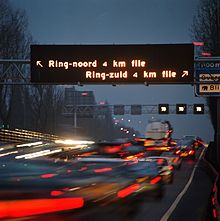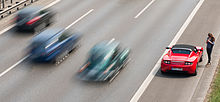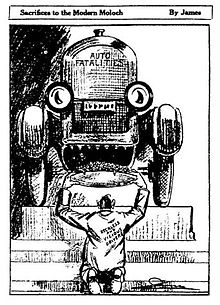
Back Verkeersveiligheid Afrikaans سلامة مرورية Arabic সড়ক নিরাপত্তা Bengali/Bangla Bezpečnost silničního provozu Czech Straßenverkehrssicherheit German Οδική ασφάλεια Greek Seguridad vial Spanish ایمنی ترافیک جاده Persian Liikenneturvallisuus Finnish Prévention et sécurité routières French





Road traffic safety refers to the methods and measures used to prevent road users from being killed or seriously injured. Typical road users include pedestrians, cyclists, motorists, vehicle passengers, and passengers of on-road public transport (mainly buses and trams).
Best practices in modern road safety strategy:
The basic strategy of a Safe System approach is to ensure that in the event of a crash, the impact energies remain below the threshold likely to produce either death or serious injury. This threshold will vary from crash scenario to crash scenario, depending upon the level of protection offered to the road users involved. For example, the chances of survival for an unprotected pedestrian hit by a vehicle diminish rapidly at speeds greater than 30 km/h, whereas for a properly restrained motor vehicle occupant the critical impact speed is 50 km/h (for side impact crashes) and 70 km/h (for head-on crashes).
— International Transport Forum, Towards Zero, Ambitious Road Safety Targets and the Safe System Approach, Executive Summary page 19[1]
As sustainable solutions for classes of road safety have not been identified, particularly low-traffic rural and remote roads, a hierarchy of control should be applied, similar to classifications used to improve occupational safety and health.[2] At the highest level is sustainable prevention of serious injury and death crashes, with sustainable requiring all key result areas to be considered. At the second level is real-time risk reduction, which involves providing users at severe risk with a specific warning to enable them to take mitigating action. The third level is about reducing the crash risk which involves applying the road-design standards and guidelines (such as from AASHTO), improving driver behavior and enforcement.[1] It is important to note that drivers' traffic behaviors are significantly influenced by their perceptions and attitudes. [3]
Traffic safety has been studied as a science for more than 75 years.[4]
Cite error: There are <ref group=Note> tags on this page, but the references will not show without a {{reflist|group=Note}} template (see the help page).
- ^ a b International Transport Forum (2008). "Towards Zero, Ambitious Road Safety Targets and the Safe System Approach". OECD. Archived from the original on 15 May 2008. Retrieved 26 January 2012.
It recognises that prevention efforts notwithstanding, road users will remain fallible and crashes will occur.
- ^ McLeod, Sam; Curtis, Carey (21 December 2020). "Integrating urban road safety and sustainable transportation policy through the hierarchy of hazard controls". International Journal of Sustainable Transportation. 16 (2): 166–180. doi:10.1080/15568318.2020.1858376. ISSN 1556-8318. S2CID 234431488.
- ^ Mehri, Mahsa; Khazaee-Pool, Maryam; Arghami, Shirazeh (2019). "Phenomenology of being a safe taxi driver". BMC Public Health. 19: 1753. doi:10.1186/s12889-019-8106-1. PMC 6937910.
- ^ Evans L (2014). "Traffic fatality reductions: United States compared with 25 other countries". Am J Public Health. 104 (8): 1501–7. doi:10.2105/AJPH.2014.301922. PMC 4103211. PMID 24922136.
© MMXXIII Rich X Search. We shall prevail. All rights reserved. Rich X Search